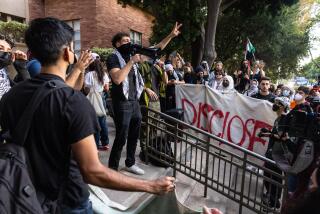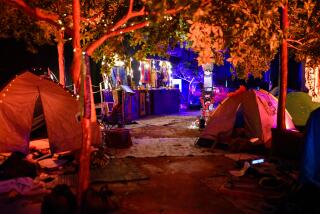Saudis Put On Quite a Show, Even Though Few Notice
When the Saudis come to town, they do it, well, like the Saudis:
- A massive weeknight fireworks display off Marina del Rey, one which took residents by surprise, flooding police phone lines with calls of concern that a gang war had broken out in Venice.
- A gala black-tie reception--heavy on shrimp, crab and shish kebab--hosted by seven Saudi princes, including the Middle East kingdom’s ambassador to the United States, Prince Bandar bin Sultan.
- And the grand opening of a free 100,000-square-foot exhibition--a sort of traveling World’s Fair pavilion--which includes everything from the gold and silver doors that once guarded the Holy Mosque in Makkah to a multimedia laser show spotlighting the urbanization of Saudi Arabia.
The series of spectacular events--which also has included business sessions between Los Angeles and Saudi commerce leaders, a political protest and even a quiet diplomatic effort by Mayor Tom Bradley between the Saudis and several Los Angeles Jewish leaders--is meant to promote a new understanding on the part of Americans toward the politically important but traditionally private Arab nation.
“It’s very simple,” said Adel Al-Jubeir, special assistant to the Saudi ambassador. “Most people have the misconception of Saudi Arabia being nothing but oil, sand and camels. We’re trying to show an accurate picture of what Saudi Arabia is about today.”
Now, all they need are crowds.
Friday morning, as a line of more than 2,000 job seekers waiting eagerly to enter a job interview mart snaked its way around the Los Angeles Convention Center grounds, a mere trickle of spectators breezed into the opening of the adjacent Saudi exhibition, which is set to run through June 30.
And the previous night at the beach, fewer than 500 viewers turned out for the fireworks, described by some as being even more spectacular than the 1984 Olympics pyrotechnics display.
Al-Jubeir said he was not worried, predicting that large lines will develop next week as word of mouth publicity supplements the Saudis’ newspaper advertising campaign. More than a million spectators, he said, have already shown up at five previous stops from Boston to Dallas.
The exhibition drew rave reviews Friday from youngsters in several school groups, many of whom seemed particularly fascinated by Hammad Rassi, a 69-year-old artisan who sat churning out leather goods in the souk (traditional marketplace) section. “One dollar” and “thank you” appeared to be the only English phrases that the Riyadh resident has picked up during his stay in America.
“This bracelet is neat,” said Erwin Artacho, a fourth-grader at Cerritos Elementary School, as he strapped on a newly purchased accessory. “And I’ve learned that Saudi Arabia is not just a desert.”
Others were just as awed by the array of dioramas, films and artifacts--but less than enamored about things that were missing, such as the presence of women among the more than 80 colorfully dressed Saudi staffers.
“There’s an ominous feeling underlying this,” said Sheri Woods, a natural food chef from Venice. “I feel I’m being courted as an American but this is a very false front. They are asking acceptance on a global scale but with a reluctance to change their traditions.”
Asked about the complaint later, Al-Jubeir said that the staffers were young Saudis studying at American colleges who volunteered for the work. No female Saudis volunteered, he said, adding that he was uncertain how many female Saudi college students are in the United States.
“There are traditional male roles and traditional female roles (in Saudi Arabia),” Al-Jubeir acknowledged. “But women are increasingly entering the work force.”
Outside the convention center, 10 protesters, disguising their identities with Arab headdresses and sunglasses, also complained about the lack of equal rights for women in Saudi Arabia.
Al-Jubeir dismissed the demonstrators, saying they were “backed and financed by the Iranians” in an effort to confuse the American public.
While the extravagant exhibition might be the public focal point of the Saudi initiative, the ambassador’s visit has included a more sensitive side behind the scenes.
At the ambassador’s invitation, Mayor Bradley had visited Saudi Arabia last March to help plan for the exhibit. The trip, which Bradley aides said also was designed to stimulate Saudi investment in Los Angeles, drew questions of concern from Los Angeles Jewish leaders.
This week, Bradley met with Rabbi Abraham Cooper of the Simon Weisenthal Center, who asked that the mayor seek to set up a meeting between Jewish leaders and the Saudi ambassador in order to discuss such issues as Soviet Jewish emigration to Israel.
Bradley spokesman Bill Chandler said Friday that the ambassador has agreed to meet with Cooper and other Los Angeles Jewish leaders, upon his return to Washington.
More to Read
Sign up for Essential California
The most important California stories and recommendations in your inbox every morning.
You may occasionally receive promotional content from the Los Angeles Times.










